Section #3 - Foreign threats to national security end with The War Of 1812
Chapter 29: Le Jour de Gloire Arrives For Napoleon And France
December 4, 1804
Napoleon Crowns Himself Emperor And Resumes War With Britain
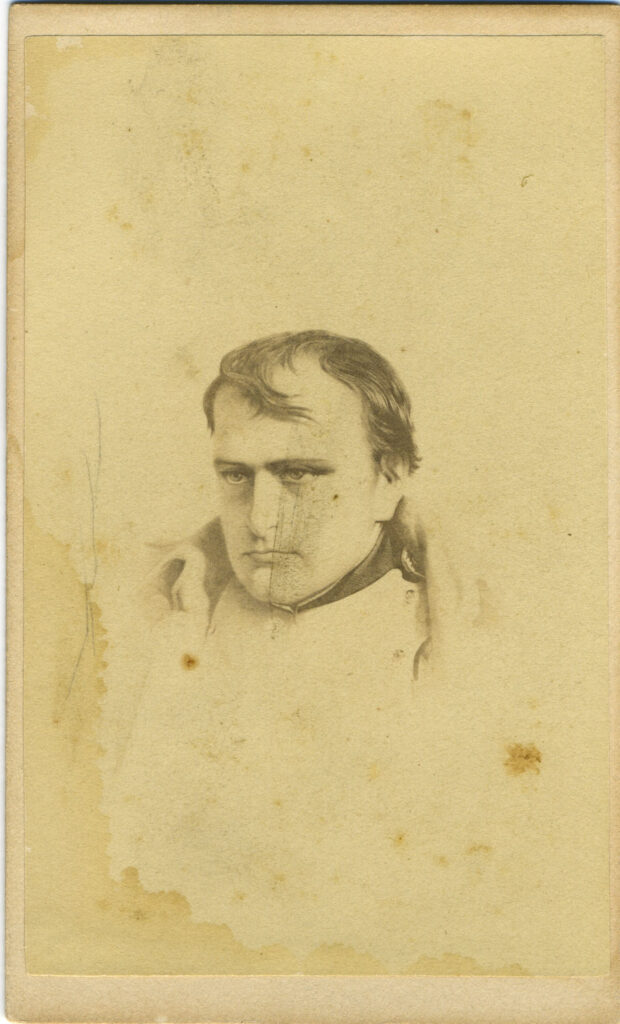
On December 2, 1804, Napoleon Bonaparte establishes hereditary power over France for his family, as he crowns himself Emperor at Notre Dame Cathedral.
The service is designed to mimic the standards set for royal successions across Europe.
To insure that Napoleon will reign “in the eyes of God,” Pope Pius VII attends the ceremony in person. The 62 year old pontiff has been in office for four years, and is intent on restoring the Church’s standing in France after seeing papal authority stripped away during the people’s revolution. His first step here is the Concordat of 1801, negotiated with Napoleon as First Counsul, which recognizes Catholicism as the “religion of the great majority” in France, while dropping claims to church lands seized during the overthrow of the old order.
Napoleon enters Notre Dame after Pius is already seated. He arrives with his wife, Josephine, in a carriage drawn by eight horses. He is gowned up in an eighty pound coronation mantle, supported by four manservants, and embroidered with “golden bees,” which he favors over the traditional fleur-de-lis symbol for France.
When the moment comes for the Pope to crown him, Napoleon intercedes by placing the laurel wreath on his own head and repeating the act for Josephine as Queen. Pius then intones his blessing:
May God confirm you on this throne and may Christ give you to rule with him in his eternal kingdom.
The action is completed with Napoleon placing his hands on the Bible and declaring his civil oath of office.
I swear to maintain the integrity of the territory of the Republic, to respect and enforce respect for the Concordat and freedom of religion, equality of rights, political and civil liberty, the irrevocability of the sale of national lands; not to raise any tax except in virtue of the law; to maintain the institution of Legion of Honor and to govern in the sole interest, happiness and glory of the French people.
As absolute monarch he is now eager to turn his energy against fulfilling the “glory of the French people.”
His sights, as always, are on the British, and reversing the losses suffered four decades ago in the Seven Year’s War. He will attack them on land and sea, along with any confederates who join them.
The days of French ascendance have arrived.
La Marseillaise (1792)
| French lyrics | English translation |
| Allons enfants de la Patrie, Le jour de gloire est arrivé! Contre nous de la tyrannie L’étendard sanglant est levé, (bis) Entendez-vous dans les campagnes Mugir ces féroces soldats? Ils viennent jusque dans nos bras Égorger nos fils, nos compagnes! Aux armes, citoyens, Formez vos bataillons, Marchons, marchons! Qu’un sang impur Abreuve nos sillons! (bis) | Arise, children of the Fatherland, The day of glory has arrived! Against us tyranny’s Bloody banner is raised,(repeat) Do you hear, in the countryside, The roar of those ferocious soldiers? They’re coming right into our arms To cut the throats of our sons, our women! To arms, citizens, Form your battalions, Let’s march, let’s march! Let an impure blood Water our furrows! (Repeat) |
1715-1855
Sidebar: Roll Call Of Key 18-19th Century Foreign Monarchs
| France | Begins Reign | Ends Reign |
| Louis XV | Sept 1, 1715 | May 10, 1774 |
| Louis XVI | May 10, 1774 | Sept 21, 1792 |
| First Republic | 1792 | 1804 |
| Napoleon I | May 18, 1804 | April 11, 1814 |
| Louis XVIII | April 11, 1814 | March 20, 1815 |
| Napoleon I | March 20, 1815 | June 22, 1815 |
| Napoleon II | June 22, 1815 | July 7, 1815 |
| Louis XVIII | July 7, 1815 | Sept 16, 1824 |
| Charles X | Sept 16, 1824 | Aug 2, 1830 |
| Louis-Phillipe I | August 9, 1830 | Feb 24, 1848 |
| Second Republic | 1848 | 1852 |
| Napoleon III | Dec 2, 1852 | Sept 4, 1870 |
| England | ||
| George II | June 11, 1727 | Oct 25, 1760 |
| George III | Oct 25, 1760 | Jan 29, 1820 |
| George IV | Jan 29, 1820 | June 26, 1830 |
| William IV | June 26, 1830 | June 20, 1837 |
| Victoria | June 20, 1837 | Jan 22, 1901 |
| Spain | ||
| Charles III | Aug 10, 1759 | Dec 14, 1788 |
| Charles IV | Dec 14, 1788 | March 19, 1808 |
| Ferdinand VII | March 19, 1808 | May 6, 1808 |
| Joseph I | May 6, 1808 | Dec 11, 1813 |
| Ferdinand VII | Dec 11, 1813 | Sept 29, 1833 |
| Isabella II | Sept 29, 1833 | Sept 30, 1868 |
| Prussia | ||
| Frederick I | January 18, 1701 | February 25, 1713 |
| Frederick William I | February 25, 1713 | May 31, 1740 |
| Frederick II (Great) | May 31, 1740 | Aug 17, 1786 |
| Frederick-William II | Aug 17, 1786 | Nov. 16, 1797 |
| Frederick William III | Nov. 16, 1797 | June 7, 1840 |
| Federick William IV | June 7, 1840 | Jan 2, 1861 |
| Russia | ||
| Catherine The Great | July 9, 1762 | Nov 17, 1796 |
| Paul I | Nov 17, 1796 | Mar 23, 1801 |
| Alexander I | Mar 23, 1801 | Dec 1, 1825 |
| Nicholas I | Dec 1, 1825 | Mar 2, 1855 |
| Alexander II | Mar 2, 1855 | Mar 13, 1881 |
October 21, 1805
Napoleon’s Momentum Is Hindered Momentarily By Lord Nelson At Trafalgar
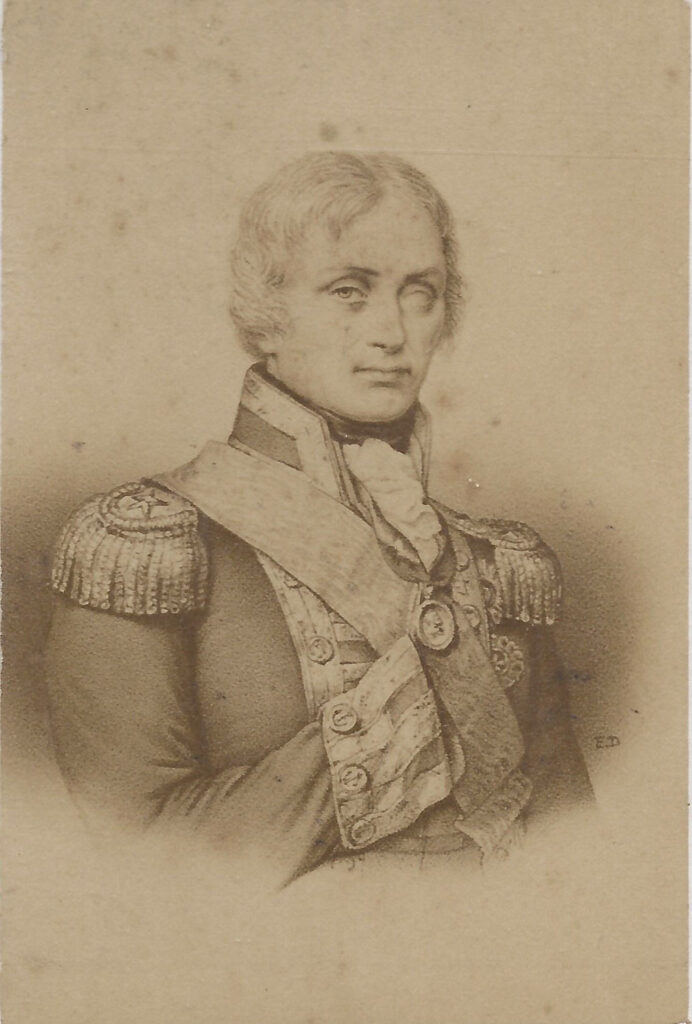
By the late summer of 1805, Napoleon has completed his plan to invade the British Isles, and has assembled a naval armada of French and Spanish ships to support the attack. But the invasion is delayed after Austria and Russia enter the war. Still, Napoleon is displeased by the lack of aggression he sees in the commanding officer of his fleet, Admiral Pierre-Charles de Villaneuve, who learns that he is about to be relieved.
On October 20, 1805, before his replacement can arrive, Villaneuve departs the port of Cadiz on the southwest coast of Spain, intending to sail south past Cape Trafalgar and the Straits of Gibraltar, into the Mediterranean and the French port of Toulon.
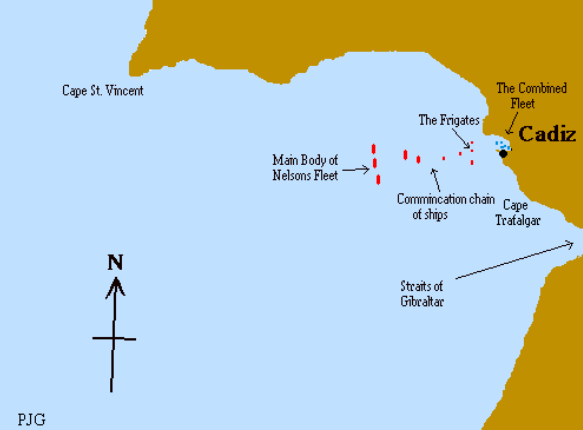
Villaneuve’s fleet is formidable, comprising 33 heavy duty warships, with some 30,000 sailors and 2,568 guns.
At 11AM on October 21, they encounter the British navy, under the command of Captain Horatio Nelson, aboard his HMS Victory.
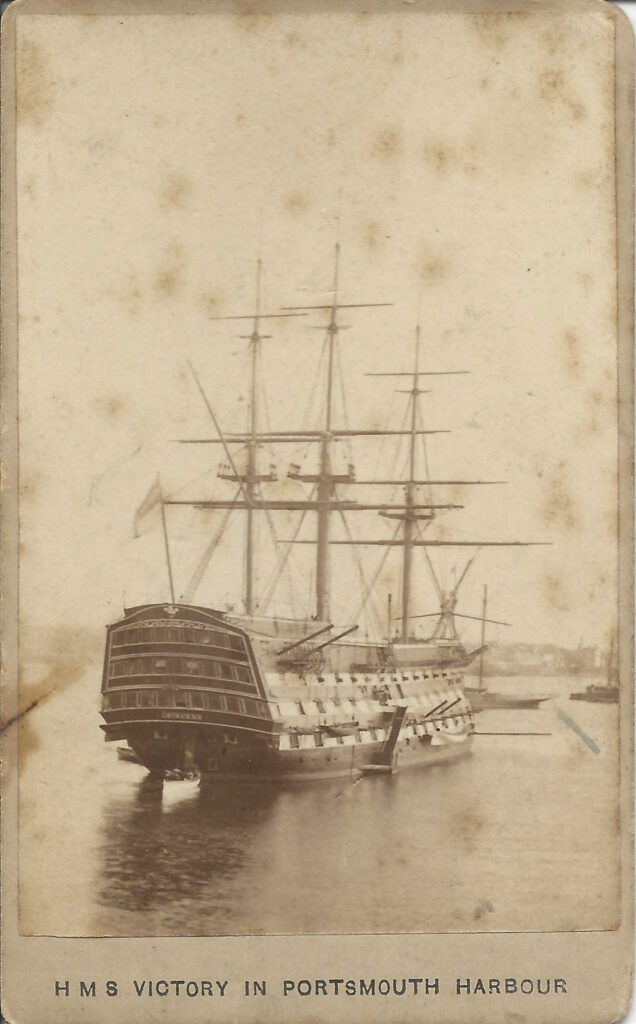
Nelson is already a legend within the Royal Navy. He enlists as an Ordinary Seaman at age twelve, serving under his uncle, Captain Maurice Suckling, who turns him into a first rate sailor, despite his lifelong bouts of seasickness. By December 1778, age twenty, he is Master and Commander of the sloop HMS Badger. He is engaged briefly around Boston and New York during America’s Revolutionary War, then becomes a national hero in February 1797, after capturing two Spanish warships at the Battle of St. Vincent.
He is almost killed on multiple occasions. In 1794 enemy shot leaves him blinded in his right eye. On July 24, 1797, his left arm is shattered by a musket ball while leading a failed landing party assault on the Canary Island city of Santa Cruz de Tenerife. Amputation follows. In 1798 Nelson is knocked unconscious by shrapnel during the victorious Battle of the Nile. Afterwards he is awarded the honorary titles of Baron and Viscount.
On October 21, 1805, Nelson has been battling the British and French off and on for some twelve years. He is 47 years old and Vice Admiral of the White (ensign) Fleet, second highest command in the Royal Navy. He has 27 warships at his disposal, with 17,000 men and 2,148 guns.
At 8AM the two fleets spot each other from a distance, the French still heading south toward Gibraltar, the English coming at them from the west. Villaneuve order his four-masters “to wear” (or jibe), reversing course to head back to Cadiz. But Nelson keeps coming onto him. The famous command — “England expects that every man will do his duty”—is flagged up.
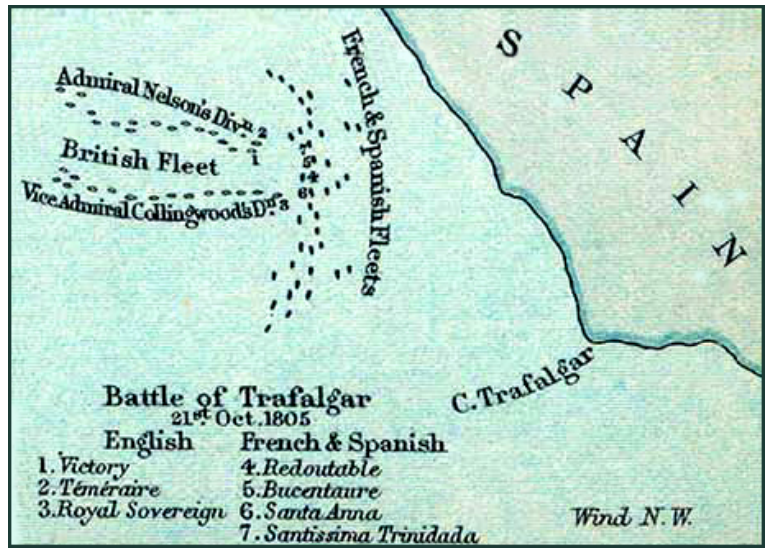
Around noon, the ships close on one another, with traditional naval strategy calling for Nelson to turn and “form lines of battle” stations parallel to the enemy. Instead, he plows straight ahead, striking the French in perpendicular fashion, and bringing on a “pell-mell” series of ship-against-ship action favorable to his more skilled seaman. This move, executed at no small risk of receiving initial broadside fire, also allows him to shoot into the sterns of many French ships, with the fire traveling through the entire length of the ship, to the bow.
Nelson himself commands the lead ship, HMS Victory, into the fray.
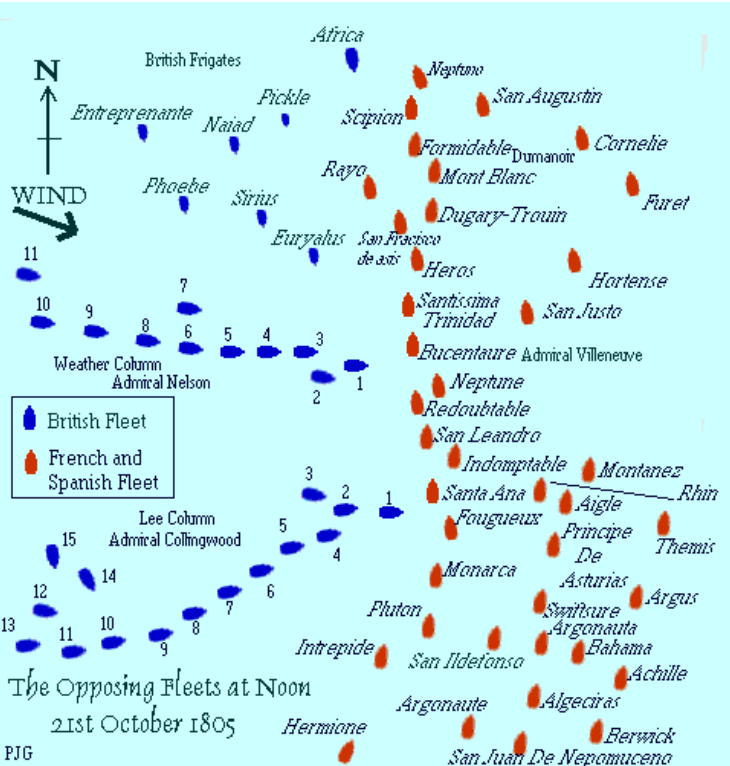
British Line Of Battle
| Weather Column | Lee Column |
| 1. Victory 2. Temeraire 3. Neptune 4. Leviathan 5. Conqueror 6. Agamemnon 7. Britannia 8. Ajax 9. Orion 10. Minotaur 11. Spartiate | 1. Royal Sovereign 2. Bellisle 3. Colossus 4. Mars 5. Tonnant 6. Bellerophon 7. Achille 8. Polyphemus 9. Revenge 10. Swiftsure 11. Defence 12. Thunderer 13. Defiance 14. Prince 15. Dreadnought |
As Victory locks with the French Redoubtable, a musket ball takes Nelson in the left shoulder, slices through his seventh cervical vertebrae and lodges in his right shoulder. He knows immediately that the wound is fatal, and says so to his surgeon.
You can do nothing for me. I have but a short time to live. My back is shot through.
He lingers below decks for another 3½ hours, still issuing orders, before succumbing to his wound. His last words are recorded as “Thank God I have done my duty.”
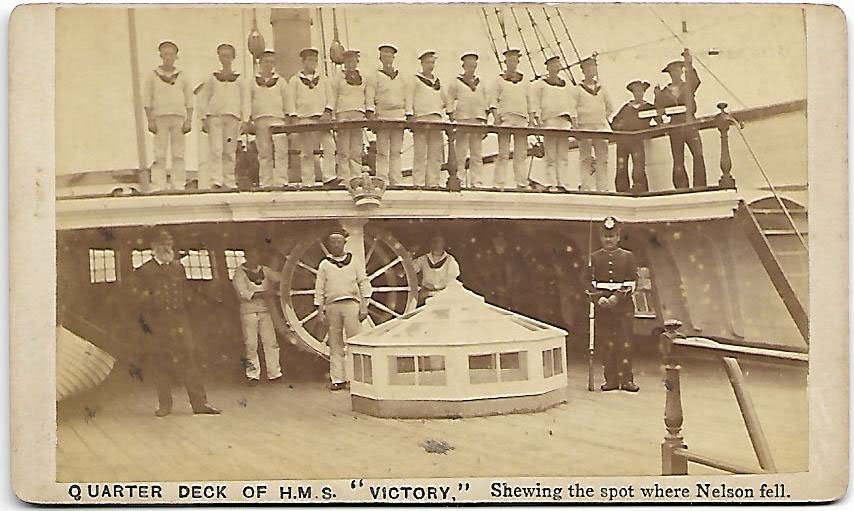
And his victory at Trafalgar is striking. Villaneuve’s fleet has suffered one ship sunk, seventeen ships captured, another eleven partially damaged and only four escaping unscathed. Some 4,500 of their seamen are killed, with another 2,400 wounded and 7,000 taken prisoner. On the British side, no ships are lost for good and total dead and wounded total 1,450.
The Royal Navy has again demonstrated its supremacy on the high seas, and Napoleon casts aside all thoughts of an invasion of the English Isles.
Despite this, Britain mourns the loss of its most famous admiral. His body is packed inside a cask of brandy and other agents for preservation. This is towed home alone with his wounded ship, Victory. On January 9, 1806, England’s most famous naval figure is interred at St. Paul’s Cathedral.
December 2, 1805 – October 14, 1806
On Land, The French Win One Major Battle After Another
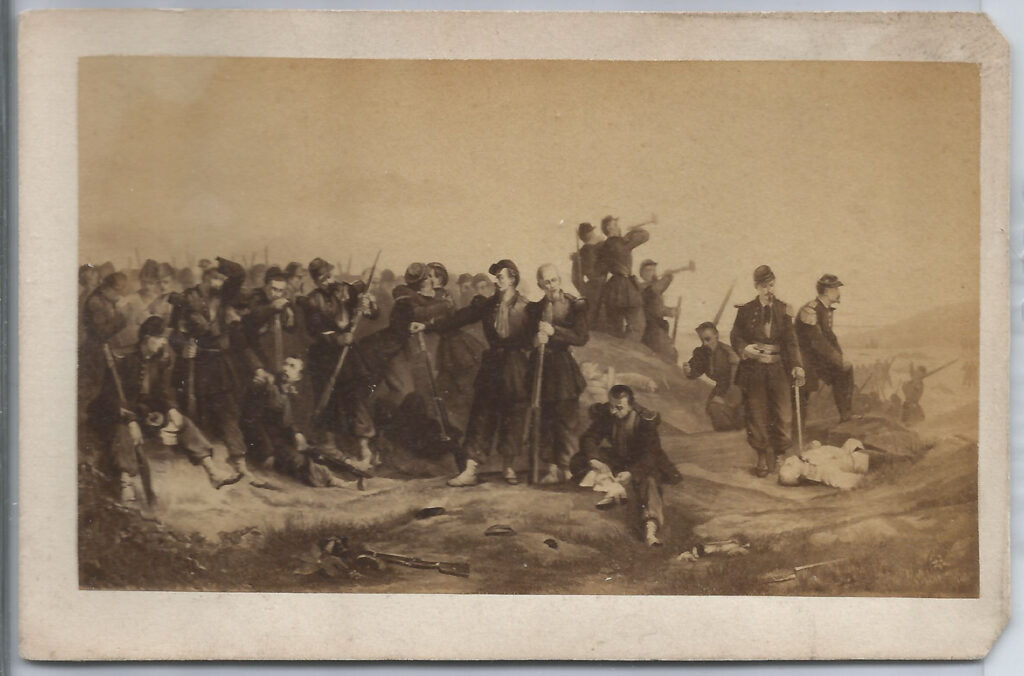
Napoleon is characteristically undaunted by the loss at Trafalgar.
On December 2, 1805, in the nine hour “Battle of The Three Kings” – near Austerlitz (now in the Czech Republic) — his undermanned force (73,000 vs. 86,000) pulls a stunning victory against Alexander I of Russia and the Holy Roman Emperor Francis II. Casualties for the day total a staggering 36,000 men. In response to the loss, Francis gives up his Holy Roman title and becomes simply King of Austria.
Less than a year later, on October 14, 1806, Napoleon soundly defeats the 110,000 man Prussian army, in the two-part battle of Jena-Auerstadt, winning control over territory in what is now central Germany and Poland. Casualties here are even greater than at Austerlitz, totaling 50,000 soldiers.
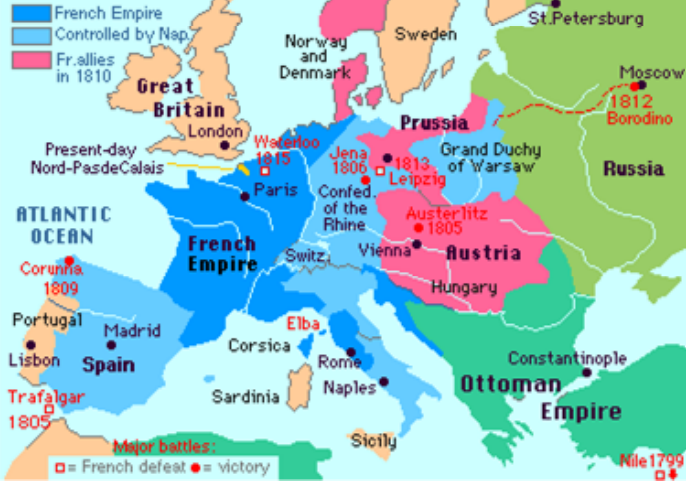
With these two pivotal triumphs, he now effectively controls all of Europe, except for Portugal, and he again moves against the British by imposing a Continental Blockade halting all trade with England in his Berlin Decree, issued on November 21, 1806.
Napoleon’s Early Campaigns
| 1792 | 1st Coalition War vs. Austria and Prussia (end 1797) |
| 1793 | Siege of Toulon (southern France) – Napoleon wins first fame |
| 1795 | N quells pro-monarchy insurrection in Paris |
| 1797 | First Italian campaign (victories at Lodi and Arcola) |
| 1798 | Expedition to Egypt and Syria |
| 1799 | N seizes power in Paris as First Counsul of the Republic |
| 2nd Coalition vs. Russia, UK, Austria, Naples, Vatican, etc (end 1802) | |
| 1800 | Second Italian campaign (victory at Marengo (nw Italy) over Austria |
| Spain trades Louisiana Territory back to France for Tuscan land | |
| France ends its Quasi-War with the US | |
| 1802 | Treaty of Amiens ends war with Britain (for one year) |
| N expanding his power over France | |
| 1803 | Britain declares war on France |
| 1804 | 3rd Coalition vs. Britain, Austria, Prussia |
| 1805 | Napoleon crowns himself Emperor of France |
| 1805 | British defeat French invasion fleet at Trafalgar |
| Battle of the Three Kings at Austerlitz – N beats Austria and Russia | |
| 1806 | 4th Coalition vs. Prussia and Russia |
| Battle of Jena-Auerstedt – N beats Prussia |